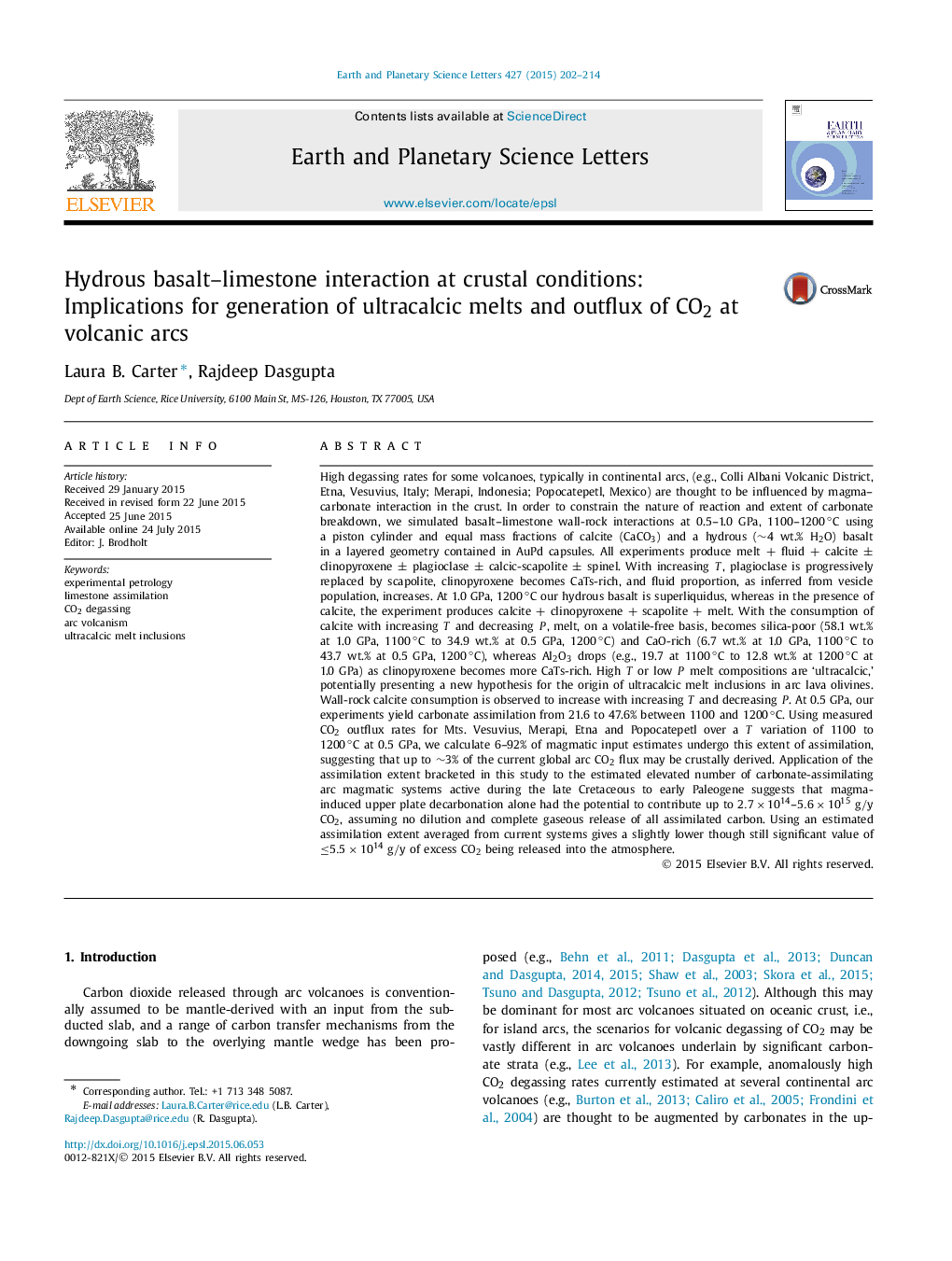| کد مقاله | کد نشریه | سال انتشار | مقاله انگلیسی | نسخه تمام متن |
|---|---|---|---|---|
| 6428088 | 1634729 | 2015 | 13 صفحه PDF | دانلود رایگان |
- Limestone assimilation in arc basalt increases with increasing T and decreasing P.
- Ultracalcic, SiO2-poor melts, plagioclase, CaTs cpx, and scapolite are produced.
- Limestone assimilation could release â¤1.1Ã1012 g/y CO2 in one Vesuvius-like system.
- â¼10-102Ã excess CO2 could have been released from the arc crust in late Cretaceous.
High degassing rates for some volcanoes, typically in continental arcs, (e.g., Colli Albani Volcanic District, Etna, Vesuvius, Italy; Merapi, Indonesia; Popocatepetl, Mexico) are thought to be influenced by magma-carbonate interaction in the crust. In order to constrain the nature of reaction and extent of carbonate breakdown, we simulated basalt-limestone wall-rock interactions at 0.5-1.0 GPa, 1100-1200â°C using a piston cylinder and equal mass fractions of calcite (CaCO3) and a hydrous (â¼4 wt.% H2O) basalt in a layered geometry contained in AuPd capsules. All experiments produce melt + fluid + calcite ± clinopyroxene ± plagioclase ± calcic-scapolite ± spinel. With increasing T, plagioclase is progressively replaced by scapolite, clinopyroxene becomes CaTs-rich, and fluid proportion, as inferred from vesicle population, increases. At 1.0 GPa, 1200â°C our hydrous basalt is superliquidus, whereas in the presence of calcite, the experiment produces calcite + clinopyroxene + scapolite + melt. With the consumption of calcite with increasing T and decreasing P, melt, on a volatile-free basis, becomes silica-poor (58.1 wt.% at 1.0 GPa, 1100â°C to 34.9 wt.% at 0.5 GPa, 1200â°C) and CaO-rich (6.7 wt.% at 1.0 GPa, 1100â°C to 43.7 wt.% at 0.5 GPa, 1200â°C), whereas Al2O3 drops (e.g., 19.7 at 1100â°C to 12.8 wt.% at 1200â°C at 1.0 GPa) as clinopyroxene becomes more CaTs-rich. High T or low P melt compositions are 'ultracalcic,' potentially presenting a new hypothesis for the origin of ultracalcic melt inclusions in arc lava olivines. Wall-rock calcite consumption is observed to increase with increasing T and decreasing P. At 0.5 GPa, our experiments yield carbonate assimilation from 21.6 to 47.6% between 1100 and 1200â°C. Using measured CO2 outflux rates for Mts. Vesuvius, Merapi, Etna and Popocatepetl over a T variation of 1100 to 1200â°C at 0.5 GPa, we calculate 6-92% of magmatic input estimates undergo this extent of assimilation, suggesting that up to â¼3% of the current global arc CO2 flux may be crustally derived. Application of the assimilation extent bracketed in this study to the estimated elevated number of carbonate-assimilating arc magmatic systems active during the late Cretaceous to early Paleogene suggests that magma-induced upper plate decarbonation alone had the potential to contribute up to 2.7Ã1014-5.6Ã1015 g/y CO2, assuming no dilution and complete gaseous release of all assimilated carbon. Using an estimated assimilation extent averaged from current systems gives a slightly lower though still significant value of â¤5.5Ã1014 g/y of excess CO2 being released into the atmosphere.
Journal: Earth and Planetary Science Letters - Volume 427, 1 October 2015, Pages 202-214
